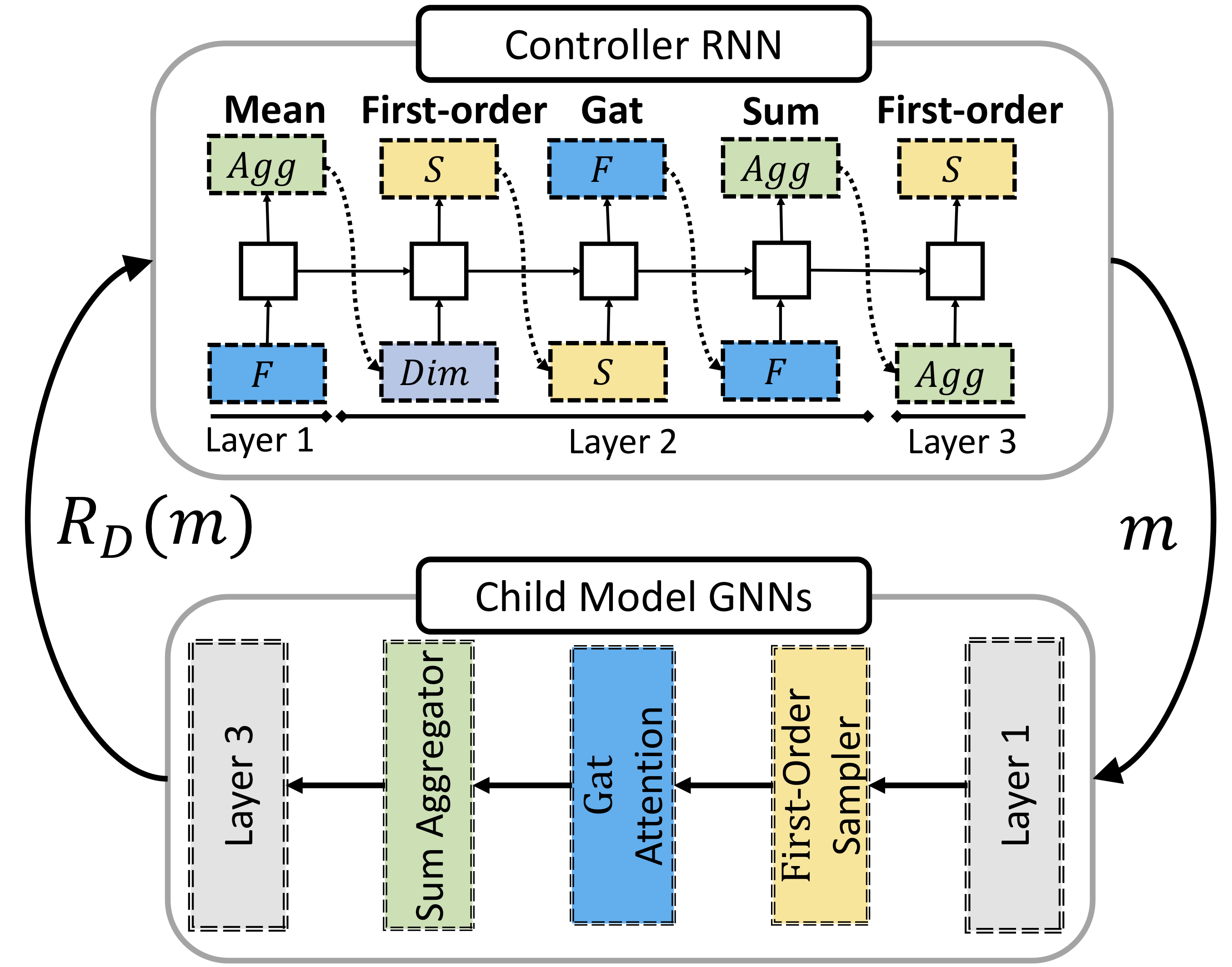GraphNAS / Graphnas
Programming Languages
Projects that are alternatives of or similar to Graphnas
GraphNAS
Overview
Graph Neural Architecture Search (GraphNAS for short) enables automatic design of the best graph neural architecture based on reinforcement learning. This directory contains code necessary to run GraphNAS. Specifically, GraphNAS first uses a recurrent network to generate variable-length strings that describe the architectures of graph neural networks, and then trains the recurrent network with a policy gradient algorithm to maximize the expected accuracy of the generated architectures on a validation data set. An illustration of GraphNAS is shown as follows:
A recurrent network (Controller RNN) generates descriptions of graph neural architectures (Child model GNNs).
Once an architecture is generated by the controller,
GraphNAS trains the architecture m on a given graph
and
test
on a validate set
.
The validation result
is taken as the reward of the recurrent network.
To improve the search efficiency of GraphNAS, we restrict the search space from an entire architecture to a concatenation of the best search results built on each single architecture layer. An example of GraphNAS constructing a single GNN layer (the right-hand side) is shown as follows:
In the above example, the layer has two input states and
, two intermediate states
and
,
and an output state
. The controller at the left-hand side samples
from
and takes
as input of
, and then samples "GAT" for processing
. The output state
collects information from
and
, and the controller assigns a readout operator "add" and an activation operator
"relu" for
. As a result, this layer can be described as a list of operators: [0, gcn, 1, gat, add, relu].
Requirements
Recent versions of PyTorch, numpy, scipy, sklearn, dgl, torch_geometric and networkx are required. Ensure that PyTorch 1.1.0 and CUDA 9.0 are installed. Then run:
pip install torch==1.1.0 -f https://download.pytorch.org/whl/cu90/torch_stable.html
pip install -r requirements.txt
If you want to run in docker, you can run:
docker build -t graphnas -f DockerFile .
docker run -it -v $(pwd):/GraphNAS graphnas python -m eval_scripts.semi.eval_designed_gnn
Running the code
Architecture evaluation
To evaluate our best architecture designed on semi-supervised experiments by training from scratch, run
python -m eval_scripts.semi.eval_designed_gnn
To evaluate our best architecture designed on semi-supervised experiments by training from scratch, run
python -m eval_scripts.sup.eval_designed_gnn
Results
Semi-supervised node classification w.r.t. accuracy
| Model | Cora | Citeseer | Pubmed |
|---|---|---|---|
| GCN | 81.5+/-0.4 | 70.9+/-0.5 | 79.0+/-0.4 |
| SGC | 81.0+/-0.0 | 71.9+/-0.1 | 78.9+/-0.0 |
| GAT | 83.0+/-0.7 | 72.5+/-0.7 | 79.0+/-0.3 |
| LGCN | 83.3+/-0.5 | 73.0+/-0.6 | 79.5+/-0.2 |
| DGCN | 82.0+/-0.2 | 72.2+/-0.3 | 78.6+/-0.1 |
| ARMA | 82.8+/-0.6 | 72.3+/-1.1 | 78.8+/-0.3 |
| APPNP | 83.3+/-0.6 | 71.8+/-0.4 | 80.2+/-0.2 |
| simple-NAS | 81.4+/-0.6 | 71.7+/-0.6 | 79.5+/-0.5 |
| GraphNAS | 84.3+/-0.4 | 73.7+/-0.2 | 80.6+/-0.2 |
Supervised node classification w.r.t. accuracy
| Model | Cora | Citeseer | Pubmed |
|---|---|---|---|
| GCN | 90.2+/-0.0 | 80.0+/-0.3 | 87.8+/-0.2 |
| SGC | 88.8+/-0.0 | 80.6+/-0.0 | 86.5+/-0.1 |
| GAT | 89.5+/-0.3 | 78.6+/-0.3 | 86.5+/-0.6 |
| LGCN | 88.7+/-0.5 | 79.2+/-0.4 | OOM |
| DGCN | 88.4+/-0.2 | 78.0+/-0.2 | 88.0+/-0.9 |
| ARMA | 89.8+/-0.1 | 79.9+/-0.6 | 88.1+/-0.2 |
| APPNP | 90.4+/-0.2 | 79.2+/-0.4 | 87.4+/-0.3 |
| random-NAS | 90.0+/-0.3 | 81.1+/-0.3 | 90.7+/-0.6 |
| simple-NAS | 90.1+/-0.3 | 79.6+/-0.5 | 88.5+/-0.2 |
| GraphNAS | 90.6+/-0.3 | 81.3+/-0.4 | 91.3+/-0.3 |
Architectures designed in supervised learning are showed as follow:
The architecture G-Cora designed by GraphNAS on Cora is [0, gat6, 0, gcn, 0, gcn, 2, arma, tanh, concat], the architecture G-Citeseer designed by GraphNAS on Citeseer is [0, identity, 0, gat6, linear, concat], the architecture G-Pubmed designed by GraphNAS on Pubmed is [1, gat8, 0, arma, tanh, concat].Searching for new architectures
To design an entire graph neural architecture based on the search space described in Section 3.2, please run:
python -m graphnas.main --dataset Citeseer
To design an entire graph neural architecture based on the search space described in Section 3.4, please run:
python -m graphnas.main --dataset Citeseer --supervised True --search_mode micro
Be aware that different runs would end up with different local minimum.



